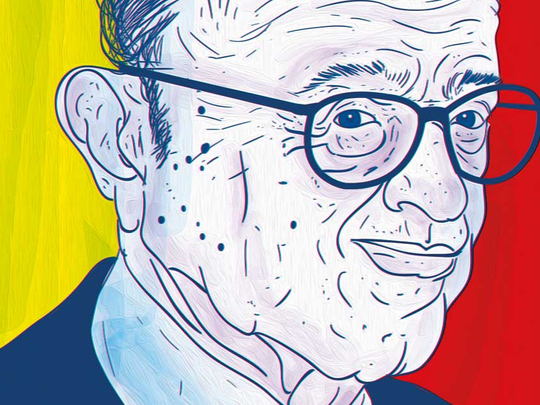
On August 11, 1987, the US Senate confirmed Alan Greenspan as chairman of the Board of Governors of the Federal Reserve System. Thirty years later, the fallout from that occasion is still being felt around the world as the central bank’s focus shifted under Greenspan from economics and the banking system to the financial industry.
Greenspan’s first speech as Fed chairman took place less than a month into his tenure when he dedicated the Jacksonville, Florida, branch of the Atlanta Fed. Some 73 miles (Dh117km) north of where he stood was Jekyll Island, Georgia, where the foundations of the Fed were first laid in November 1910.
Rather than look back at the Fed’s roots, however, Greenspan peered into its future: “We have entered the age of the truly global marketplace. Today the monetary policy decisions of our nation reverberate around the globe.”
Those words resonate today as policymakers worldwide struggle to extricate themselves from extraordinary levels of market intervention. How did we get to the point where central bankers endeavour to resolve structural issues with the power of the printing press?
Greenspan’s legacy provides the answers.
It is notable that in the days before the Senate vote, President Ronald Reagan cited the “banking system” as one of the Fed’s primary responsibilities. While Greenspan included banking system stability as one of the “instrumentalities” of the government’s designs of the Fed, he emphasised that the Fed was “NOT just another federal agency.” The Fed was also a leader “within the financial industry”.
It wouldn’t take long for the financial system to stress test Greenspan’s resolve. On October 19, 1987, the Dow Jones Industrial Average dropped 22.6 per cent in what remains the steepest one-day loss on record. From his first day in office to that October closing low, the Dow was down by 35 per cent.
Few recall that Greenspan was in the air on his way to Dallas during the worst of Black Monday’s sell-off. It wasn’t until he landed that he learnt of the day’s events. Compelled back to Washington due to the gravity of the situation, Greenspan issued the following statement in his name at 8.41am that Tuesday, less than an hour before stocks opened for trading: “The Federal Reserve, consistent with its responsibilities as the Nation’s central bank, affirmed today its readiness to serve as a source of liquidity to support the economic and financial system.”
Greenspan in turn gave new meaning to actions speaking louder than words. Via the Fed’s open market operations, interest rates were driven down by half a percentage that day.
Traders were electrified as this liquidity injection fuelled a strong rally. And this was just the beginning. As James Saft put it for Reuters in a 2012 retrospective on Black Monday, “The Fed kept at it in the coming months, operating quite publicly, and often giving trading desks advance notice, and repeatedly taking overnight interest rates lower.”
From the womb of his “advance notice”, the so-called Greenspan Put was born. In other words, investors were comfortable taking ever bigger risks knowing that Greenspan would bail out markets in times of trouble.
Greenspan’s dedication to contain investor losses would be tested time and again throughout his 18-year tenure. Over and over, he would rush to the rescue of investors who became increasingly reliant on Greenspan’s loss-mitigating interventions, placing his legacy at odds with the individual who served out the longest term as Fed chair, William McChesney Martin.
In a speech exactly 32 years before the 1987 crash to the New York Group of the Investment Bankers Association of America, Martin equated the Fed’s job to that of a “chaperone who has ordered the punch bowl removed just when the party was really warming up.”
Today, it’s fair to say that rather than remove the punch bowl, Greenspan refilled it at critical junctures, whether during the Asian debt crisis that brought down Long-Term Capital Management or the wrenching stock losses that arrived four years after he warned investors of the dangers of “irrational exuberance” in 1996.
Greenspan’s successor, Ben S. Bernanke, followed suit, launching successive rounds of quantitative easing in the aftermath of the financial crisis that heaped riches on investors but did precious little for average working Americans.
Such is the nature of the moral hazard instilled by exertions to insulate investors from feeling the painful consequences that result from speculative levels of risk taking.
The sad thing, at least according to Sebastian Mallaby’s recent biography of Greenspan, is that Greenspan had always been masterful at recognising froth in markets, whether it be equities or residential real estate.
Brilliance, though, eventually led to Greenspan’s downfall as his reputation as brilliant policymaker morphed into that of ‘Maestro’. Maintaining this perfect mystique eventually required he intrude upon markets’ ability to set prices. Moral hazard naturally followed.
In closing that first fateful speech in Jacksonville, Greenspan assured his audience of his solid constitution: “Plainly, there are obstacles ahead. But equally obviously, challenges we know are challenges that we can meet.”
As we mark the 10-year anniversary of the financial crisis, perhaps the next generation of central bankers would be best guided in the knowledge that there are some challenges they cannot meet.
Learn from Greenspan’s fallibility and thereby appreciate the limits of monetary policymaking.












